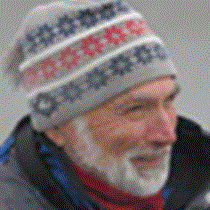LeConte Bay and Petersburg
We awoke to exquisite shades of gray and densely-packed, forested slopes rising from a tranquil sea punctuated by floating ice. Parts of towering snow-capped mountains played peekaboo with strands of wispy mist that shifted about as we approached LeConte Bay.
After icebergs calve, or fall into the ocean, from the face of LeConte Glacier and drift at the whims of tidal flow, many become stranded on shoals that are elongated piles of rubble left behind by the conveyer-belt action of glaciers. This description doesn’t give a clue to the incredible sculptural beauty of these massive objects that seem to emit an unworldly blue that challenges one for words. We explored the largest and most striking ones we could by Zodiac in the short time we had. Bright and dramatic light broke through the overcast. Most photographers probably took more pictures here than at any other place on our trip. As the tide rose, bits of bergs broke free of the bottom to travel again. In 1853, ships from San Francisco came here to collect ice for shipment south, and around fifty years later, the town of Petersburg was established, partly because of the easy access to ice.
After a program by one of our naturalists on Pacific Northwest native culture, our ship’s officers docked the National Geographic Sea Bird in Petersburg. It’s nestled next to the Wrangell Narrows, with a spectacular backdrop of high mountains. This community has one of Alaska’s most prosperous fishing fleets, its inhabitants (many with a Norwegian heritage) are friendly and genuine, tourism is at a minimum, and bald eagles are abundant, to name just a few of its attributes. Those who walked about town enjoyed the rosemaling on buildings and brass fish outlines imbedded in the sidewalks. In a place like this it’s the simple stores like those selling hardware or fishermen’s supplies that are often the most interesting.
One group wandered around the docks looking at the vast array of purse seiners, tenders, gillnetters and trollers, while others crossed the Wrangell Narrows and walked to a spectacular muskeg, an Algonquin name for a sphagnum bog. More than ten percent of Alaska is covered with this mossy and acidic ecosystem that looks like a bonsai garden, delicately arranged and planted, down to the tiniest of sundew leaves. These carnivorous plants gain nutrients while avoiding the highly acidic water by capturing a smattering of tiny insects on their sticky hairs. Digestion is helped by enzymes on the surface of their leaves. We looked at many species in bloom, including bog laurel, Labrador tea, sticky tofieldia, bog rosemary and bog bean.
After a memorable dinner of fresh crab and ribs we relaxed in the lounge with fruit cobbler and a fascinating program on humpback whales by Dr. Andy Szabo, the director of the Alaska Whale Foundation. He helped us gain a better understanding of the complex foraging strategy of these cetacean giants.




